Engineering a serum-resistant and thermostable vesicular stomatitis virus G glycoprotein for pseudotyping retroviral and lentiviral vectors
- PMID: 23364315
- PMCID: PMC3735647
- DOI: 10.1038/gt.2013.1
Engineering a serum-resistant and thermostable vesicular stomatitis virus G glycoprotein for pseudotyping retroviral and lentiviral vectors
Abstract
Vesicular stomatitis virus G glycoprotein (VSV-G) is the most widely used envelope protein for retroviral and lentiviral vector pseudotyping; however, serum inactivation of VSV-G pseudotyped vectors is a significant challenge for in vivo gene delivery. To address this problem, we conducted directed evolution of VSV-G to increase its resistance to human serum neutralization. After six selection cycles, numerous common mutations were present. On the basis of their location within VSV-G, we analyzed whether substitutions in several surface exposed residues could endow viral vectors with higher resistance to serum. S162T, T230N and T368A mutations enhanced serum resistance, and additionally K66T, T368A and E380K substitutions increased the thermostability of VSV-G pseudotyped retroviral vectors, an advantageous byproduct of the selection strategy. Analysis of a number of combined mutants revealed that VSV-G harboring T230N+T368A or K66T+S162T+T230N+T368A mutations exhibited both higher in vitro resistance to human serum and higher thermostability, as well as enhanced resistance to rabbit and mouse serum. Finally, lentiviral vectors pseudotyped with these variants were more resistant to human serum in a murine model. These serum-resistant and thermostable VSV-G variants may aid the application of retroviral and lentiviral vectors to gene therapy.
Conflict of interest statement
The authors declare no conflict of interest.
Figures
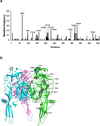
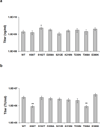

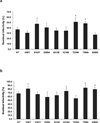

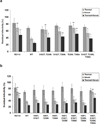




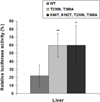
Similar articles
-
Selection of novel vesicular stomatitis virus glycoprotein variants from a peptide insertion library for enhanced purification of retroviral and lentiviral vectors.J Virol. 2006 Apr;80(7):3285-92. doi: 10.1128/JVI.80.7.3285-3292.2006. J Virol. 2006. PMID: 16537595 Free PMC article.
-
Efficiency of onco-retroviral and lentiviral gene transfer into primary mouse and human B-lymphocytes is pseudotype dependent.Hum Gene Ther. 2003 Feb 10;14(3):263-76. doi: 10.1089/10430340360535814. Hum Gene Ther. 2003. PMID: 12639306
-
The Dual-Pseudotyped Lentiviral Vector with VSV-G and Sendai Virus HN Enhances Infection Efficiency through the Synergistic Effect of the Envelope Proteins.Viruses. 2024 May 23;16(6):827. doi: 10.3390/v16060827. Viruses. 2024. PMID: 38932120 Free PMC article.
-
Lentiviral Vector Pseudotypes: Precious Tools to Improve Gene Modification of Hematopoietic Cells for Research and Gene Therapy.Viruses. 2020 Sep 11;12(9):1016. doi: 10.3390/v12091016. Viruses. 2020. PMID: 32933033 Free PMC article. Review.
-
Altering the tropism of lentiviral vectors through pseudotyping.Curr Gene Ther. 2005 Aug;5(4):387-98. doi: 10.2174/1566523054546224. Curr Gene Ther. 2005. PMID: 16101513 Free PMC article. Review.
Cited by
-
Molecular Engineering of Virus Tropism.Int J Mol Sci. 2024 Oct 15;25(20):11094. doi: 10.3390/ijms252011094. Int J Mol Sci. 2024. PMID: 39456875 Free PMC article. Review.
-
COVID-19 Pandemic: Review of Contemporary and Forthcoming Detection Tools.Infect Drug Resist. 2021 Mar 17;14:1049-1082. doi: 10.2147/IDR.S289629. eCollection 2021. Infect Drug Resist. 2021. PMID: 33762831 Free PMC article. Review.
-
Xenoantigen-Dependent Complement-Mediated Neutralization of Lymphocytic Choriomeningitis Virus Glycoprotein-Pseudotyped Vesicular Stomatitis Virus in Human Serum.J Virol. 2019 Aug 28;93(18):e00567-19. doi: 10.1128/JVI.00567-19. Print 2019 Sep 15. J Virol. 2019. PMID: 31243134 Free PMC article.
-
Suppressing or Enhancing Macrophage Engulfment through the Use of CD47 and Related Peptides.Bioconjug Chem. 2022 Nov 16;33(11):1989-1995. doi: 10.1021/acs.bioconjchem.2c00019. Epub 2022 Mar 22. Bioconjug Chem. 2022. PMID: 35316023 Free PMC article. Review.
-
Vesiculovirus neutralization by natural IgM and complement.J Virol. 2014 Jun;88(11):6148-57. doi: 10.1128/JVI.00074-14. Epub 2014 Mar 19. J Virol. 2014. PMID: 24648451 Free PMC article.
References
-
- Rosenberg SA, Aebersold P, Cornetta K, Kasid A, Morgan RA, Moen R, et al. Gene transfer into humans--immunotherapy of patients with advanced melanoma, using tumor-infiltrating lymphocytes modified by retroviral gene transduction. N Engl J Med. 1990;323:570–578. - PubMed
-
- Edelstein ML, Abedi MR, Wixon J. Gene therapy clinical trials worldwide to 2007--an update. J Gene Med. 2007;9:833–842. - PubMed
-
- Sheridan C. Gene therapy finds its niche. Nat Biotechnol. 2011;29:121–128. - PubMed
-
- Braun S. Muscular gene transfer using nonviral vectors. Curr Gene Ther. 2008;8:391–405. - PubMed
Publication types
MeSH terms
Substances
Grants and funding
LinkOut - more resources
Full Text Sources
Other Literature Sources
Medical

